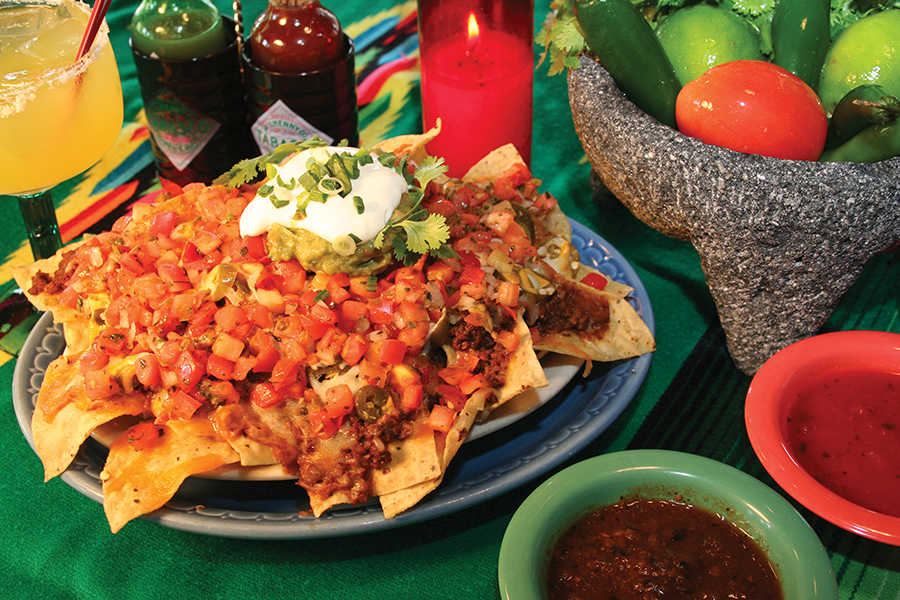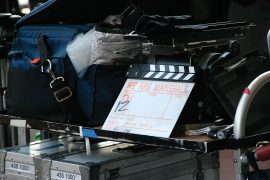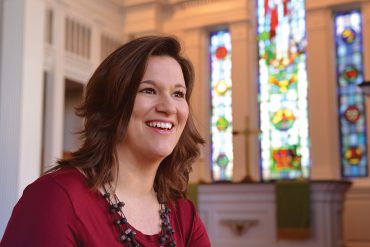HQ takes a look back at the 25 things we miss most in Huntington from the past 25 years.
By Carter Taylor Seaton
HQ 87 | AUTUMN 2014
We know that to progress we have to look forward, but sometimes nostalgia wins the day and we long for what we used to have. HQ polled its staff and Facebook fans to learn the 25 things they miss most that have closed since the magazine was born in 1989. Not surprisingly, many are restaurants. After all, we do love to eat. Here’s our list in no particular order.
Ashland Oil
As you cross from West Virginia into Kentucky on I-64, you see, sitting along the Big Sandy River’s Kentucky bank, the brightly burning refinery and mammoth storage tanks that for years bore the familiar red, white and blue logo of Ashland Oil. This Fortune 500 company, founded by Paul Blazer in 1924, was one of the region’s largest employers and best corporate neighbors until a series of mergers and division re-alignments took its headquarters from Ashland. While the refinery has a different logo now, with Ashland Oil’s departure we lost a significant number of high-paying jobs, as well as the corporation’s largesse to local charities, foundations, Marshall University, the Huntington Museum of Art and other worthwhile endeavors.
Chili Willi’s Mexican Cantina
Nestled in a relatively small nook along Fourth Avenue, this wildly popular 32-seat restaurant was bursting with atmosphere. Huntington natives home for a visit, as well as out-of-towners, made a beeline here first to get their fiesta fix. Waiting lines were common, but no one cared. Marshall students, retirees and families loved its Tex-Mex menu, especially the signature chili and ice cream tacos. The crowd followed owner Ron Smith as Chili Willi’s moved to a larger space up the avenue a few blocks in 2005. Sadly, the 2008 recession was about to hit. The restaurant closed three years later, a victim of the sagging economy.
CM Love Hardware
Need an outdated door latch, some varnish, a key made? Back in the day, you could have popped over to CM Love Hardware and someone would have gotten it for you. How about a Fast Flyer wagon or a fully decorated tree for Christmas? Garden tools? They had those, too. After 100 years of personal service, the business closed in 2010. The recently renovated building now houses local law firm Campbell Woods.
Bailey’s Cafeteria
When women wore gloves and hats to shop, Bailey’s was where the ladies would lunch, waiting in line for hot rolls, fried chicken, mashed potatoes, gravy and pies to die for. Home-cooked food away from home – that was Bailey’s for more than 60 years. No plastic water pitchers here, Bailey’s used the iconic Blenko glass pitchers. Some, like Congressman Ken Hechler, ate here every day. And which did the pint-sized diners love more: watching the waiter as he spirited away the dirty dishes or picking from the basket of toys the waitresses offered at the end of the meal?
Owens-Illinois Glass
Another of our big employers with a heart to match, Owens-Illinois Glass was one of the nation’s largest manufacturers of glass bottles and jars. For 60 years, the landmark factory near the Memorial Arch was so important to the city that the Ohio Valley Bus Company named one route the “Ninth and 11th – Owens” to mark its westernmost stop. When it closed in 1993, the loss of those 650 jobs was a major blow to the community.
The Peanut Shoppe

Conveniently located a few steps from the Keith-Albee Theatre, the aroma of hot roasted peanuts lured many a moviegoer to buy movie-munchies there instead of those at the Keith’s concession stand. And they didn’t offer only nuts, although cashews were high on most shoppers’ lists. Malted milk balls, chocolate-covered raisins, giant gumballs, hard candies and gumdrops – they had them all. The Peanut Shoppe lasted in downtown Huntington for more than 80 years, finally closing in 2009.
Pilgrim Glass

Once upon a time, glass manufacturing was king in West Virginia. When founder Alfred Knobler established Pilgrim in 1949, it quickly became a major producer of art glass. Today its crackle glass, cranberry glass and cameo glass pieces are highly coveted collector’s items. Located in Ceredo just below Tri-State Airport, Pilgrim boasted the sculptural talents of Italian glass artists Alessandro and Roberto Moretti for nearly 50 years. Many mourned the loss of the Christmas open house as an eagerly awaited gift-buying opportunity when the company closed in 2002.
Frank’s Sandwich Shop
Home of the steak sandwich, sprinkled with “hots,” Frank’s was one of the most popular quick food hangouts in town. The steak was thinly sliced – and whatever type of peppers the “hots” were, they gave the sandwich just the right kick. Conveniently located on the corner of Third Avenue and 13th Street near the college, many Marshall students lived on owner Frank Volk’s sandwiches and hot dog specials.
Stone & Thomas Department Store
Also remembered by many as Anderson-Newcomb, it was the last of the large department stores in downtown Huntington. Its layout is imprinted on our memories: cosmetics and perfume to the left of the front entrance, shoes near the elevators, women’s clothing on the second floor, children’s on four and Fanny Farmer chocolates tucked away near the almost-hidden back door. Overhead pneumatic tubes whisked sales slips to the mezzanine office for processing. During the Christmas season, the first-floor chandeliers dripped with tinsel garlands or evergreen swags. It was a one-stop, in-town shopping mecca where you could buy almost anything you needed.
Victor’s Delicatessen
It was the place to go for fans of matzo ball soup, chopped liver, incredible sandwiches and crisp salads. The air was always pungent with the mixed aromas of the day’s specials. Arrive late, and you’d wait for a seat to open. Parking was limited, but you wouldn’t have known that inside. Within walking distance from most offices, the restaurant buzzed with conversation. Some called it the gathering place for Huntington’s movers and shakers. If you couldn’t get a seat, there was always carry-out service with owner Herman Brodof calling your name when the order was ready.
Big Bear Supermarkets
“The Bear” was a little bit grocery shopping, a lot visiting with neighbors. Three dotted the city: at First Street, at Hal Greer near Cabell Huntington Hospital and on 29th Street, now home to St. Mary’s School of Nursing. Another store served Ceredo and Kenova. The stores offered freshly cut meat, great produce, full shelves, a bakery, a deli, your favorite legal beverages and customer-friendly carry-out service. And don’t forget your trading stamps.
Nick’s News & Card Shop
It’s a rare store that draws both businessmen and children, but Nick’s did. Big-city newspapers from across the country lined one wall while a huge selection of comic books lined the other. Nearby the Classic Comics favored by high schoolers who couldn’t bring themselves to read the assigned novels revolved on a standing rack. Magazines, popular books and cards rounded out the offerings by Ernie Tweel, who founded the store that was a Ninth Street landmark for years.
Dwight’s Drive-Ins

Hungry after a late-night date? Dwight’s Kingburger with its classic sauce or a piece of famous strawberry pie should do the trick. Both the Eighth Street and First Street locations were popular late-night hangouts when every other place had closed for the evening. With breakfast served all day, curb service via speakers and killer coffee, the 24-hour restaurants were a tradition in Huntington until the last one closed in 2003.
Movies at the Keith-Albee
The twinkling stars, the clouds above your head and the gilded Spanish-baroque sculptures flanking the stage sometimes made it hard for first-timers to the old vaudeville house to concentrate on the movie. Movie-going at the Keith was magical. Before it was sliced into three theaters, the opulent showplace seated 2,000 people; and the release of a blockbuster film often filled it. The scent of fresh popcorn filled the lobby. As the lights dimmed, the heavy red curtains parted; and with your popcorn and candy in hand, you were transported to another world. Fortunately, with the ongoing transformation of the grand old movie house into the Keith-Albee Performing Arts Center, the magic is still possible.
Ming’s Restaurant

In the 1970s, when Ming Eng opened his restaurant in the former Elephant Walk, it seemed as if the menu didn’t match the décor. Nevertheless, for almost 30 years patrons relished Ming’s cuisine – especially the cinnamon rolls that accompanied the Chinese meals. Now, for some, Chinese food isn’t the same without them. When he closed at the Frederick, he moved Ming’s to the Stone Lodge for another 10 years. Then in 2009, he threw in his chef’s hat for good, leaving us still wanting another course.
Spring Valley Country Club
On Spring Valley Road in the western part of Huntington there once was another country club. It sported a hilltop clubhouse and an 18-hole course with an abundance of hills and a few water hazards. Opened in 1905, the course was home to the WV Open in 1949, the year Sam Snead became the first five-time winner of the competition with his almost flawless performance. Many Huntington families have fond memories of swimming, playing tennis or golfing there. The semi-private club closed in 2008.
The Veterans Memorial Field House
Check your memories of days gone by and you are sure to have at least one that includes the Field House. Marshall basketball’s glory days? The Catholic Tournament, later the Saint Joseph’s Invitational? Holiday on Ice and the public skating afterward? Professional wrestling? The Harlem Globetrotters? The Boy Scout Jamboree? We remember them all fondly but recognize the need for moving on. Now we have Marshall’s new soccer complex on that site that will create its own share of good memories.
Torlone’s Community Bakery
Torlone’s was a family-owned institution in Huntington for almost 50 years. Staffed during the day by the cigar-chomping Dominic Torlone, the bakery featured pastries from sweet-rolls to elaborate wedding cakes. Torlone’s community service was as legendary as his sweets. Each week, the bakery donated baked goods to local churches, veterans’ homes and the City Mission. After the Marshall plane crash, the staff cleared the shelves, donating everything to feed the rescue workers. Closed in 1995, the Eighth Street location now houses Francois’ Bakery.
Robby’s Bar
Although its location on Third Avenue has had a checkered history, Robby’s once dominated Huntington’s club scene. The dance club is remembered with nostalgic fondness as the place to see and be seen. Named for its original owner, baseball legend Donnie Robinson, the club featured baseball memorabilia décor, numerous tables, a semi-circular bar, a double staircase to the upper deck and a huge dance floor! It was one of the first places to show videos, and its light show was unrivaled.
Ward’s Donuts
In the wee hours of the morning, if you needed a cup of coffee and a small snack, you headed to Ward’s. Offering “Deliciously Different Donuts” that owner Paul Ward claimed were an “old family recipe,” it was open 24 hours a day. The small hole-in-the-wall restaurant on Fourth Avenue and 14th Street captured the appetites of college students, late-night partiers, shift workers and everyone in between for more than 50 years. Today the aroma that surrounds the building is Italian. It’s the home of Rocco’s Little Italy.
Huntington Cubs
For a while, having a minor league baseball team in Huntington put us on the map for something other than collegiate sports. The Cubs played at St. Cloud’s Commons in the West End from 1990-1994. Associated with the Chicago Cubs as part of the Appalachian League, the Cubs finished the 1990 season in second place. Although only a few players advanced to the majors, baseball was alive and well while the Cubs were here.
Mycroft’s Restaurant & Bar

The daily crowd at Mycroft’s usually included Marshall professors, students, businessmen and couples. For more than 20 years, on game days, the popular spot at Seventh Avenue and 20th Street turned Marshall green, crowded and chaotic. Memorable sandwiches included the Nitty Gritty Grinder and the Monte Cristo. The dinner menu offered broader choices. Now, both Mycroft’s and the building are merely nostalgic memories.
The Pied Piper
What began as a small music shop on Fourth Avenue grew into a virtual musical institution in Huntington and beyond. Founded in 1967 by brothers Chuck and Larry Levine, it grew from a small Fourth Avenue shop that displayed drums on the second floor balcony to a block-long building on Third Avenue where lessons, sheet music and electronics competed for space with musical instruments ranging from penny whistles to pianos. Started because the brothers felt the music market was under served, its closing recreated that void.
Rebels & Redcoats Tavern
“Fine dining in a bowling alley? You are kidding me, right?” That was the typical reaction of first-timers to Rebels. When it first opened as a full-service restaurant, Rebels offered an extensive menu and wine list. On weekends, the small dance floor, flanked by a large wood-burning fireplace, was usually crowded with dancers swaying to the live music. Rustic wooden booths, Blenko stained-glass windows and red glass goblets gave the intimate gathering spot a Williamsburg feel. While Rebels is still open, the current owners have returned it to its original tavern feel with a limited menu from the bowling alley’s grill.
Broughton Ice Cream
Before frozen yogurt and gelato found Huntington, we all screamed for ice cream and many of us thought Broughton’s was the best, at least on the Southside. Hovering at the edge of the First Street underpass on Seventh Avenue, in the summer Broughton’s parking lot was packed as tightly as its cones. Some shoppers couldn’t get past vanilla on the extensive list of flavors; others sampled broadly. In either case, it was rich and delightful. Broughton’s is gone now, but we still scream for ice cream.
Ahh, those were the days…





